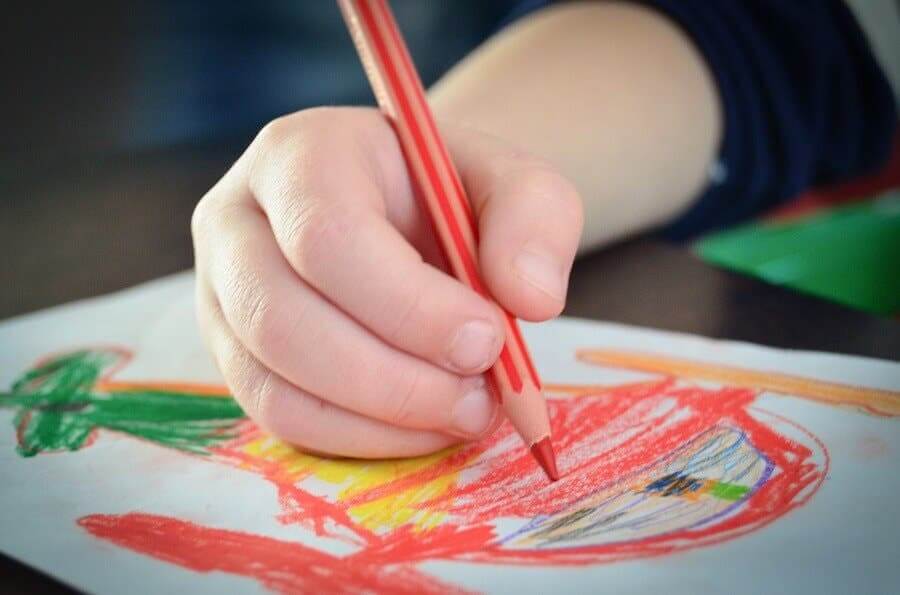How to Help Children Channel Their Anger

As adults, we realize how beneficial it can be to maintain emotional balance in every area of our lives. But, when and how did we learn this lesson? Now we can appreciate the importance of giving our children the tools they need to manage their emotions. With this in mind, from a young age, we need to help children channel their anger in the best way possible.
What is anger?
Anger is an internal force that erupts, almost like a volcano, in response to a situation that we don’t like. It’s classified as one of the primary emotions that human beings experience. What’s more, we need it in order to realize when something’s bothering us. And thanks to these internal manifestations – an increase in adrenaline and blood pressure – we realize that something’s awry.
Children experience these sensations internally but they don’t know how to find a way to express them “properly.” In other words, without shouting, throwing things, breaking things, slamming doors… So, how can we help children channel their anger?

Discover: “The Color Monster” – 3 Lessons for Kids
Guidelines on how to help children channel their anger
If you’re a parent, then you’ve already realized that saying “don’t yell”, “don’t hit” and “don’t cry” won’t make your child’s anger go way. Therefore, we need to come up with a more effective strategy.
- Stay calm. Parents are a reflection of their children. If we’re not able to stay under control when we’re angry, how can we expect our children to learn to do so? In the midst of a fit of anger, it’s crucial that we talk to our kids in a calm but firm tone. Remember, if you reply aggressively, you’re most likely going to make your child feel even more furious.
- Don’t allow violence by any means: Breaking things, hitting, self-injury, shouting, insults. You should respect your child’s feelings, but you shouldn’t respect any means of expressing them. Parents need to be very clear about what we won’t tolerate and establish clear limits regarding those behaviors.

Helping children learn to channel their anger isn’t about stern reprimands. On the contrary, it’s about allowing kids to manifest their feelings, but in a way that doesn’t hurt them or others.
- Accompany the emotion. Children don’t know how to deal with the pleasant emotions they’re feeling. Whether it’s fear, anger, or frustration, on many occasions, anger is the only way to express themselves. You can help them calm down and reduce the intensity of the emotion by suggesting they go to their room for a few minutes. Or, you can simply stay nearby until they calm down.
- Help them recognize the feeling of anger. Once the storm is over, it’s time to talk about what happened. This gives children the opportunity to reflect on why they reacted the way they did and how they feel afterward.
- Offer alternatives for expressing anger. It’s normal to feel angry sometimes, but we need to have other resources to release that anger. Give children the opportunity to talk about it and teach them relaxation techniques.
- Praise your child’s post-anger behavior. Praise children when they regain composure and when they express their feelings verbally and in a calm manner.
- Use warning systems. Many times, explosions occur without children even realizing they’re getting angry. If we can warn them when we notice the first signs of anger, like restlessness or muscle tension, we can help them recognize anger. One of these systems is the stoplight technique.
- Help them find activities that are incompatible with tension. Sports and relaxation techniques like yoga and mindfulness contribute to a sense of wellbeing that’s just the opposite of what anger produces.

You may also want to read: The Importance of the Language We Use With Our Family
In conclusion…
Emotional self-regulation is a developmental process that we, as parents, need to guide. It’s not something that will happen overnight. We need to be sure to help them along the way in a loving but firm way.
The truth is, our children need to learn to self-regulate correctly and express their emotions in the right way. If not, they may experience a variety of problems over the course of their lives.
As adults, we realize how beneficial it can be to maintain emotional balance in every area of our lives. But, when and how did we learn this lesson? Now we can appreciate the importance of giving our children the tools they need to manage their emotions. With this in mind, from a young age, we need to help children channel their anger in the best way possible.
What is anger?
Anger is an internal force that erupts, almost like a volcano, in response to a situation that we don’t like. It’s classified as one of the primary emotions that human beings experience. What’s more, we need it in order to realize when something’s bothering us. And thanks to these internal manifestations – an increase in adrenaline and blood pressure – we realize that something’s awry.
Children experience these sensations internally but they don’t know how to find a way to express them “properly.” In other words, without shouting, throwing things, breaking things, slamming doors… So, how can we help children channel their anger?

Discover: “The Color Monster” – 3 Lessons for Kids
Guidelines on how to help children channel their anger
If you’re a parent, then you’ve already realized that saying “don’t yell”, “don’t hit” and “don’t cry” won’t make your child’s anger go way. Therefore, we need to come up with a more effective strategy.
- Stay calm. Parents are a reflection of their children. If we’re not able to stay under control when we’re angry, how can we expect our children to learn to do so? In the midst of a fit of anger, it’s crucial that we talk to our kids in a calm but firm tone. Remember, if you reply aggressively, you’re most likely going to make your child feel even more furious.
- Don’t allow violence by any means: Breaking things, hitting, self-injury, shouting, insults. You should respect your child’s feelings, but you shouldn’t respect any means of expressing them. Parents need to be very clear about what we won’t tolerate and establish clear limits regarding those behaviors.

Helping children learn to channel their anger isn’t about stern reprimands. On the contrary, it’s about allowing kids to manifest their feelings, but in a way that doesn’t hurt them or others.
- Accompany the emotion. Children don’t know how to deal with the pleasant emotions they’re feeling. Whether it’s fear, anger, or frustration, on many occasions, anger is the only way to express themselves. You can help them calm down and reduce the intensity of the emotion by suggesting they go to their room for a few minutes. Or, you can simply stay nearby until they calm down.
- Help them recognize the feeling of anger. Once the storm is over, it’s time to talk about what happened. This gives children the opportunity to reflect on why they reacted the way they did and how they feel afterward.
- Offer alternatives for expressing anger. It’s normal to feel angry sometimes, but we need to have other resources to release that anger. Give children the opportunity to talk about it and teach them relaxation techniques.
- Praise your child’s post-anger behavior. Praise children when they regain composure and when they express their feelings verbally and in a calm manner.
- Use warning systems. Many times, explosions occur without children even realizing they’re getting angry. If we can warn them when we notice the first signs of anger, like restlessness or muscle tension, we can help them recognize anger. One of these systems is the stoplight technique.
- Help them find activities that are incompatible with tension. Sports and relaxation techniques like yoga and mindfulness contribute to a sense of wellbeing that’s just the opposite of what anger produces.

You may also want to read: The Importance of the Language We Use With Our Family
In conclusion…
Emotional self-regulation is a developmental process that we, as parents, need to guide. It’s not something that will happen overnight. We need to be sure to help them along the way in a loving but firm way.
The truth is, our children need to learn to self-regulate correctly and express their emotions in the right way. If not, they may experience a variety of problems over the course of their lives.
This text is provided for informational purposes only and does not replace consultation with a professional. If in doubt, consult your specialist.








